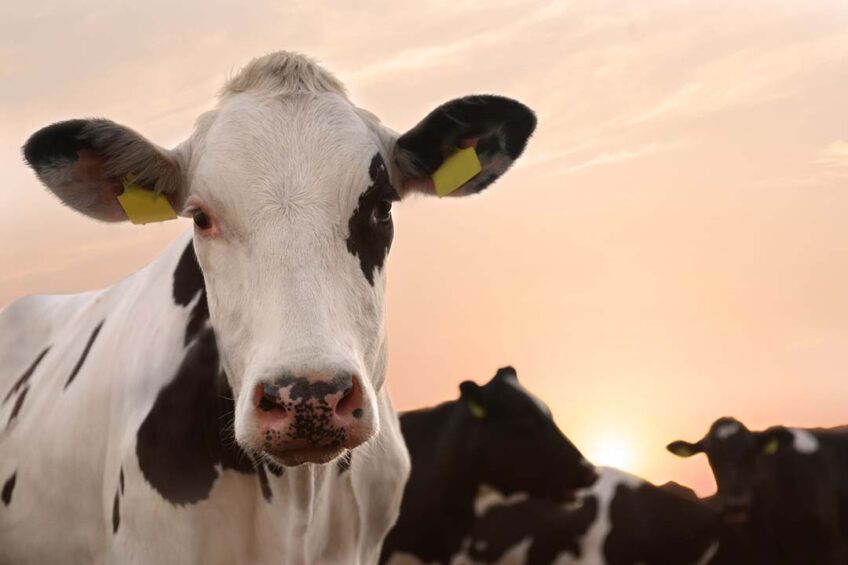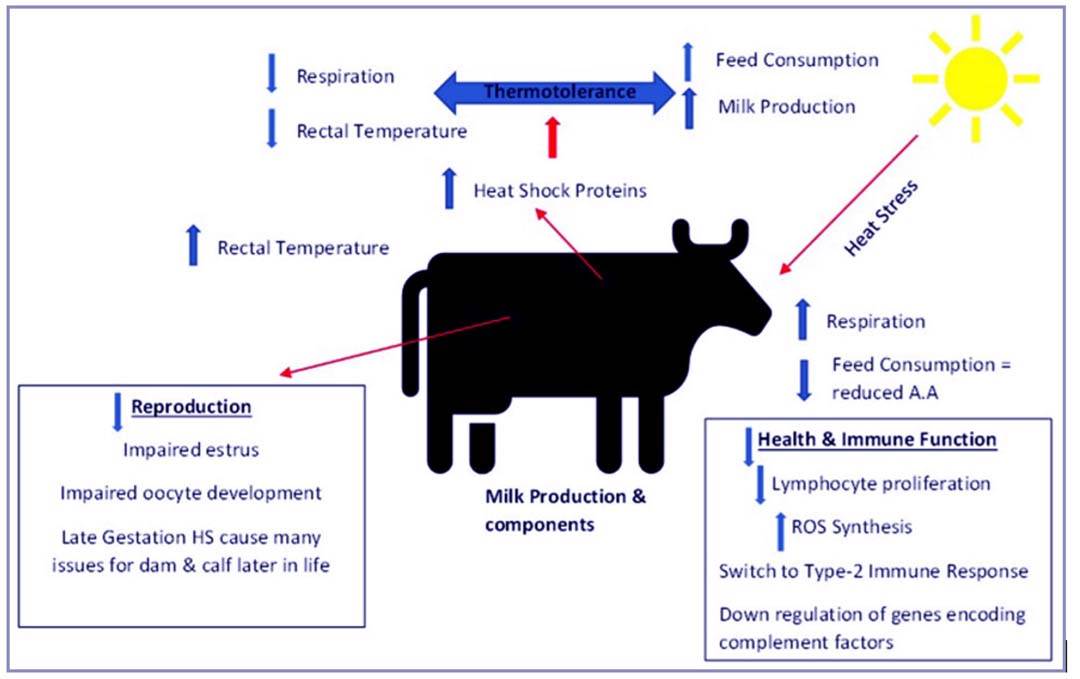Selection strategies for thermotolerance in dairy cattle

Climate change is driving the increase in frequency of hot days and heat waves. In turn, this increases the risk of heat stress in livestock with dairy cattle the most susceptible due to their high metabolic heat load. In a recent study, researchers highlight the pros and cons of the various selection strategies for thermotolerance in dairy cattle.
Reports show that heat stress, which is a serious issue for dairy cattle, will continue to persist as long as climate change continues. Heat stress results in large economic losses in the dairy industry due to reductions in milk production, reproductive issues and increases in treatment costs due to increased disease occurrence.
Previous estimates conducted in the US have reported global losses of approximately US$1.2 billion per year in lactating cows due to heat stress. To understand why such losses occur, we must first understand the physiological response to heat stress. Figure 1 shows a summary of the main effects of heat stress and thermotolerance in dairy cattle.
Figure 1 — Summary of impacts of heat stress on dairy cattle

Selection strategies for thermotolerance
Selecting for reduced milk production
One selection strategy proposed to achieve thermotolerance is the selection for reduced milk production. This is likely since increase in milk production results in generating greater metabolic heat loads. Previous studies show that when selecting cows based on this selection index for heat tolerance and then exposing them to a heat challenge, the heat-tolerant cows have less decline in yield, lower respiration rates and lower increases in rectal temperatures versus heat-susceptible cows. In addition, heat-tolerant cows return to baseline yield values faster than the heat-susceptible cows.
However, the biggest issue with this selection index is that cattle will now be bred to have reduced production traits. In other words, although heat-tolerant cattle will have lower reductions in yield during times of heat stress, their overall 305-day milk yield will probably be lower compared to that of heat-susceptible animals. Hence, in countries with varying seasons throughout the year, researchers suggest this might not be the ideal selection strategy to establish thermotolerance in dairy cattle.
Crossbreeding and gene editing
Another potential selection strategy for thermotolerance is crossbreeding Bos indicus breeds with Bos taurus breeds. Bos indicus breeds, which are common in tropical regions, have been shown to have a greater ability to adapt to thermal stress compared to Bos taurus breeds. Bos indicus breeds are shown to have a greater ability to control body temperature, reduce metabolic rates and an increased ability to dissipate heat. Therefore, crossbreeding Bos taurus breeds with Bos indicus breeds could be a relatively easy way to introduce heat-tolerant genes into Bos taurus breeds, ultimately resulting in thermotolerance.
However, Bos indicus cattle typically have lower milk production, therefore, by crossbreeding with Bos indicus breeds even though it may result in producing thermotolerant offspring, these offspring is also likely to have lower yields relative to Bos taurus breeds. It is also highlighted that crossbreeding with Bos indicus breeds may result in offspring that are less tolerant to colder temperatures. Hence, in countries with varying seasons, this may not be the ideal solution, as these crossbred offspring would have an increased risk for cold stress in winter.
Another genetic strategy that has been suggested is to use gene editing to introduce specific genes or mutations that result in resilience to heat stress. One example is the SLICK haplotype which occurs due to a deletion in an exon of the prolactin receptor; the SLICK mutation causes changes to the coat of cattle resulting in shorter hair and lower follicle density across the coat. The issue with introducing this mutation into Bos taurus breeds is that since it changes the cattle’s coat phenotype to produce a coat that allows for enhanced heat dissipation, it is also possible it will, in turn, increase the risk of cold stress in these animals.
Selection for physiological and cellular traits
One promising solution that could work to confer thermotolerance in dairy cattle from various locations across the world is to select for the various physiological traits involved in cooling during heat stress. Respiration rate and rectal temperature are both traits that could be included in selection programmes to confer thermotolerance. However, studies in dairy cattle have shown low heritability, especially for respiration rate, indicating it would take longer to make genetic gains when selecting on this trait.
On the other hand, cellular traits have also been identified as being associated with thermotolerance. Nitric oxide synthesis is one cellular trait associated with thermotolerance as it facilitates the vasodilation of skin during heat stress, which helps in dissipating heat to the environment.
Although selecting for physiological and cellular traits seems a promising strategy to confer thermotolerance with having little or no effect on milk production, the major drawback is that using these traits in a selection index is costly and labour intensive to measure, making it quite difficult to obtain large data sets on these traits.
Selection for high immune response
Immune response is another trait associated with thermotolerance. It is possible to select dairy cattle that can mount a high immune response. Recent evidence has shown that dairy cattle identified as high immune responders are more thermotolerant than those identified as average and low responders. Multiple studies have shown high immune responding dairy cattle have lower respiration rates at higher THI values compared to average and low-responding dairy cattle.
According to the researchers, selecting for high immune response in dairy cattle is now relatively easy and cost-effective and appears to be an ideal selection strategy.
“Previous studies have shown no difference in milk production between high immune responders and their herd mates. Therefore, selecting for high immune response in dairy cattle seems to be an ideal cost-effective selection strategy to confer thermotolerance while maintaining production and minimising cold stress,” they said.
Based on the original article by Shannon, L. Cartwright., Julie Schmied., Niel Karrow., and Bonnie, A. Mallard. 2023: Impact of heat stress on dairy cattle and selection strategies for thermotolerance: a review. Frontiers in Veterinary Science.
Join 13,000+ subscribers
Subscribe to our newsletter to stay updated about all the need-to-know content in the dairy sector, two times a week.










